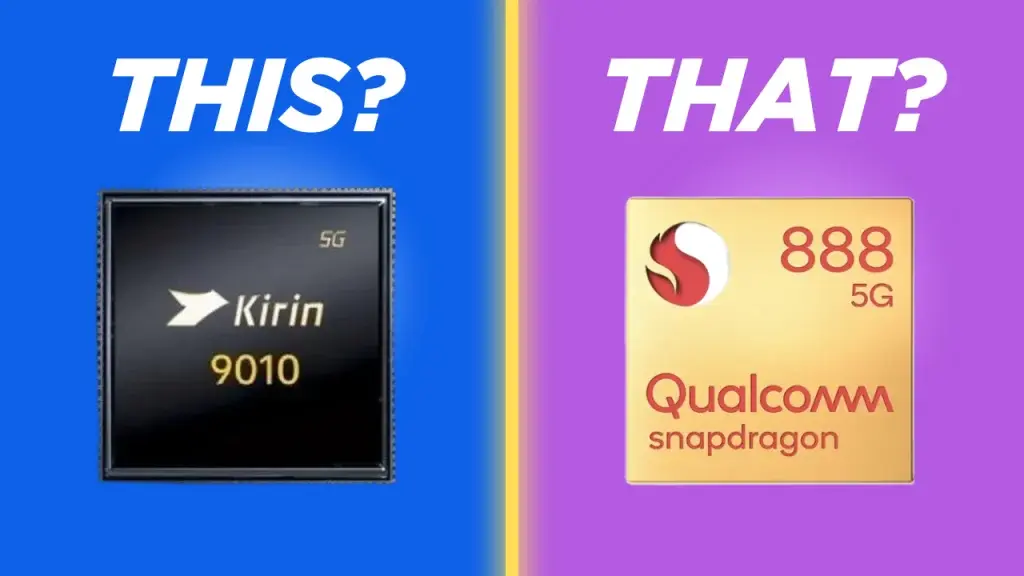The Snapdragon 8 Gen 3 surpasses the Kirin 9010 by a considerable margin in our evaluation. However, the question remains: can Huawei’s flagship chip compete with the 3-year-old Snapdragon 888 chip?
Detailed Comparison: Kirin 9010 vs. Snapdragon 888
To determine whether investing in a Kirin 9010 is worthwhile or if opting for a Snapdragon 888-powered phone remains the superior choice, a comprehensive comparison is essential.
Overview
The Qualcomm Snapdragon 888 SoC stands out as a robust chip known for its presence in flagship and premium mid-range smartphones. On the contrary, Huawei’s Kirin 9010, despite being labeled a flagship chip, falls short in benchmarking performance, failing to truly earn its flagship status.
Quick Comparison Table:
| Feature | Kirin 9010 | Snapdragon 888 |
|---|---|---|
| Process Node | 7nm (SMIC) | 5nm (Samsung) |
| CPU Cores | 1 x 2.3 GHz Taishan Big | 1 x 2.84 GHz Cortex-X1 |
| 3 x 2.18 GHz Taishan Mid | 3 x 2.42 GHz Cortex-A78 | |
| 4 x 1.55 GHz Cortex-A51 | 4 x 1.8 GHz Cortex-A55 | |
| GPU | Maleoon 910 @ 750 MHz | Adreno 660 @ 792 MHz |
| RAM | – | Up to 24GB LPDDR5 @ 3200 MHz |
| 5G | Yes | Yes |
| Download/Upload | – | Up to 7500 Mbps/3000 Mbps |
Technical Details
Huawei’s Kirin 9010 chipset is fabricated by SMIC on the 7nm process, while the Snapdragon 888 utilizes Samsung’s 5nm process. The denser transistor configuration in the Snapdragon 888 contributes to enhanced performance at lower power consumption levels compared to the Kirin 9010.
The Snapdragon 888’s cores operate at higher clock speeds than those of the Kirin 9010, making it better equipped for intensive processing tasks. Nevertheless, factors such as thread management, storage speed, and software optimization play significant roles in determining overall performance.
Despite the Adreno 660 GPU in the Kirin 9010 running at a lower clock speed than the Snapdragon 888’s, the 3DMark Wild Life Extreme benchmark results present a different narrative.
Benchmarking Performance
Kirin 9010 SoC:
- AnTuTu v10: 972,547
- Geekbench v6 (single-core): 1,446
- Geekbench v6 (multi-core): 4,524
- 3DMark Wild Life Extreme: 1,531
Snapdragon 888 SoC:
- AnTuTu 10: 892,658
- Geekbench v6 (single-core): 1,498
- Geekbench v6 (multi-core): 3,948
- 3DMark Wild Life Extreme: 1,498
The Kirin 9010 (7nm) outperforms the Snapdragon 888 (5nm) in various benchmark tests, albeit the disparities are not substantial. It is important to note that benchmark results may not fully reflect real-world performance.
Final Verdict: Kirin 9010 vs. Snapdragon 888
Both the Kirin 9010 and Snapdragon 888 stand as high-performance mobile chipsets, showcasing comparable performances on benchmarking platforms. The decision between the two becomes challenging, with the Snapdragon 888 holding advantages such as its utilization of a 5nm processor node, superior to the Kirin 9010’s 7nm process. Furthermore, the lack of detailed information on the Kirin 9010 raises concerns, with reports suggesting it is a modified version of the Kirin 9000s. Hence, based on these considerations, opting for the Snapdragon 888 over the Kirin 9010 seems prudent.
For more chip comparisons, check out:
- Kirin 9010 vs Snapdragon 8 Gen 3
- MediaTek Dimensity 7050 vs. Snapdragon 6 Gen 1
- Snapdragon 8s Gen 3 vs Snapdragon 7+ Gen 2
- Snapdragon 7+ Gen 3 vs. Snapdragon 8 Gen 2


Leave a Reply